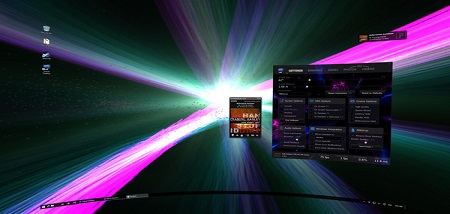
Is Desktop Theater Mode worth purchasing a Vive for? Probably not. Anything you can see on your desktop can be routed through the Vive. While In-Home Streaming requires some fidgeting to-for instance-stream from VLC, Valve’s Desktop Theater Mode seems to work more like the Virtual Desktop app for the Oculus Rift. You’re also not limited to Steam apps, from what Valve tells me. Valve says any game that runs above 30 frames per second should work, no problem, and that you can still pull up the Steam Overlay from within the VR environment. But with minimal delay, the game output signal is routed onto this massive screen.

Valve tells me that the Desktop Theater Mode uses some of the same technology employed for its Steam In-Home Streaming and Broadcast features-either some incredible foresight on Valve’s part, or lucky happenstance.
#STEAM VR DESKTOP MOD#
(Valve didn’t provide screenshots of the experience for publication.) Valve wink-wink-nudged me though that we shouldn’t be surprised if Desktop Theater Mode is opened up to Steam Workshop in the near future, allowing the community to mod in their own fantastical/realistic/sci-fi environments at will.Īnyway, I played Broforce. The “virtual home theater” itself is pretty minimalist, largely avoiding the sort of faux-realism we saw in Netflix’s fake living room/cabin last year.
#STEAM VR DESKTOP UPDATE#
The latest Virtual Desktop update also brings higher quality video compression on Nvidia GPUs, especially at lower resolutions and high bitrates, independent of SGSR and SSW.įor a full list of improvements and fixes, check out Guy Godin’s Reddit post.Not that there’s much to see aside from the screen. If the frame rate drops below a critical level, SSW generates artificial intermediate images to ensure a smooth gaming experience.
#STEAM VR DESKTOP PC#
More good news for PC VR gamers with less powerful systems: Super Resolution and the Synchronous Space Warp (SSW) rendering technique developed by Godin can be used simultaneously without any drawbacks. These are currently the Meta Quest 2, Meta Quest Pro, Pico Neo 3, and Pico Neo 4. Super Resolution requires a headset that supports Virtual Desktop and runs on a Qualcomm Snapdragon XR 2 chip. “The option works with Potato, Low, Medium quality (up to 120fps) and High (up to 90fps) and it upscales to Ultra resolution under the hood”, Godin writes on Reddit. This feature will primarily help PC VR gamers with older or weaker GPUs.

Virtual desktop developer Guy Godin and Qualcomm worked together to integrate Super Resolution into Virtual Desktop. By utilizing super resolution, platforms, and applications, developers can increase the display resolution while meeting framerates and maintaining visual fidelity.” Higher resolution without performance costs “Super resolution techniques create higher resolution images from lower resolution inputs by refining details and enhancing features to produce sharp and clear visuals while using less resources than native rendering.

Qualcomm describes the feature as follows: This upscaling technology is similar to AMD’s FidelityFX Super Resolution, but is optimized for Qualcomm’s Snapdragon mobile chips, which are also used in VR headsets. Yesterday, a major update was released for the popular VR app Virtual Desktop, bringing an exclusive new feature to its PC VR streaming: Snapdragon Game Super Resolution support, or SGSR for short.


 0 kommentar(er)
0 kommentar(er)
